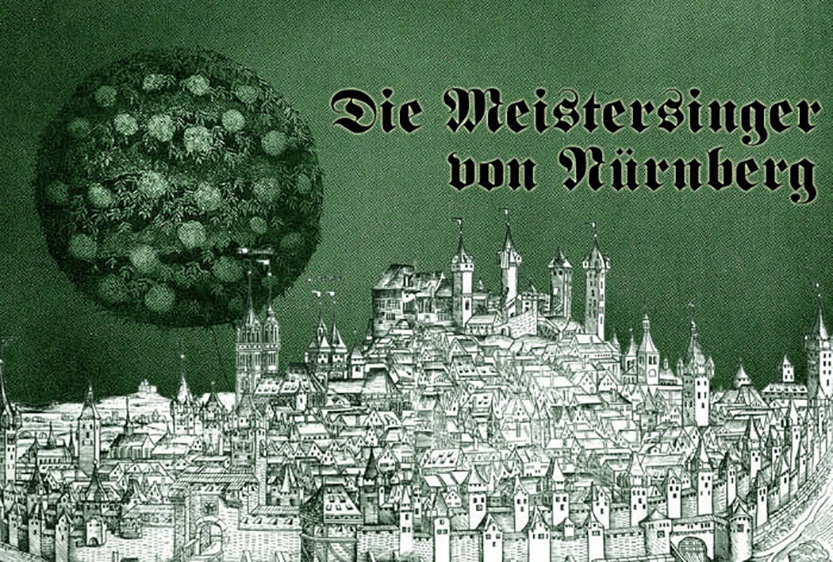
Wieland Wagner's 1956 staging of Die Meistersinger von Nürnberg was not only the crowning achievement of his postwar "New Bayreuth" style, but it also turned out to be his most controversial production. |
When the Bayreuth Festival reopened in 1951 with Wieland Wagner's landmark production of Parsifal, the director's principal artistic aim was to rid his grandfather's operas of any references to German nationalism and its disturbing links to the Third Reich. Year after year, Wieland applied his sanitizing approach to all his new productions. The results created a style that, at first, met with strong audience and critical resistance, but ultimately came to be accepted as the preferred way to stage Richard Wagner's operas in the 20th century. When it came time to stage Die Meistersinger, Wieland's directorial style met its greatest resistance. This was an opera that was rooted in German history and tradition and set in one of the most important and historic places in the nation. The city had not only been the center of the German Renaissance and home of painter Albrecht Dürer, but also the national shrine of the Nazis who held their annual party congresses there from 1933 to 1938. The city was also the birthplace of the 1935 "Nuremberg Laws" that deprived German Jews of their civic rights. Due to its strategic importance, it was heavily bombed during the war and largely destroyed. It was also the seat of the postwar tribunal for war crimes. Wieland had to somehow eliminate all of the recent negative connotations in order to present the work in a new light. |
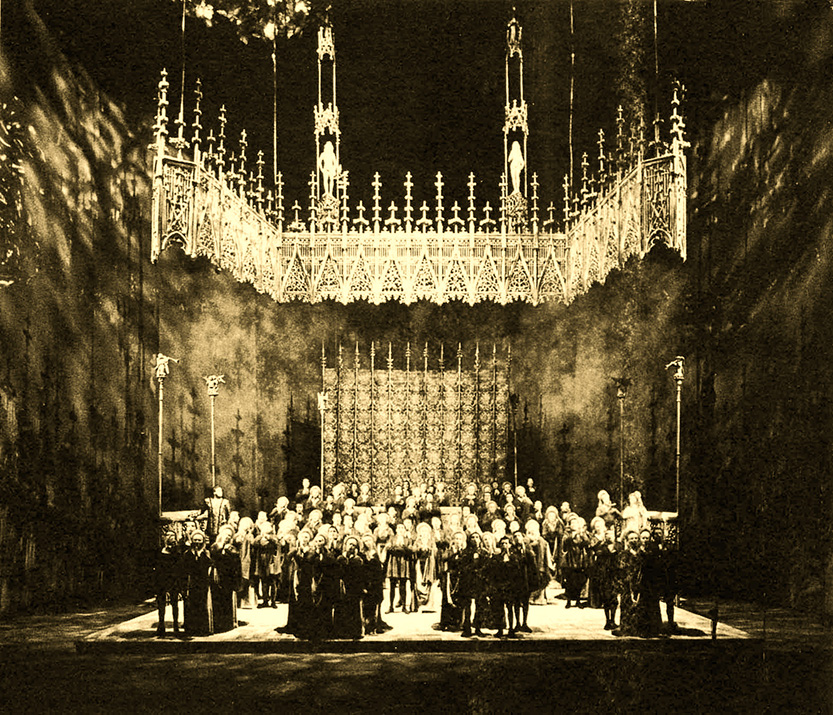
Wieland Wagner's 1956 staging of Die Meistersinger von Nürnberg: ACT I |
The conservative faction at Bayreuth always feared the inevitable time when Wieland Wagner would decide to mount a New Bayreuth-style production of the beloved, and very German, Meistersinger. In 1951, Wieland Wagner wrote in his essay "Tradition and Innovation" that "Die Meistersinger calls for a certain naturalism, imposed by a historically fixed time, a geographical place, and human beings of flesh and blood." The director's earlier point of view, however, was not too much consolation, especially for those who had actually experienced one of Wieland's recent productions. During the months before the 1956 summer unveiling the very worst was expected. At its premiere, the first act of the new production was greeted with much approval. Nuremberg's beloved St. Katharine's Church, the fabled meeting place of the Meistersinger singing school (which was completely gutted by fire during the Allied air-raids of World War II) had been faithfully and lovingly recreated. When the curtain rose on Act II, however, the smiles that had greeted the start of the opera disappeared. Instead of the expected narrow street, Wieland offered an empty stage with a kidney-shaped performing space (perhaps a giant footprint, after all Hans Sachs is a cobbler), adorned by a giant ball of leaves and flowers that hung above the characters with a magical-realism defiance of the laws of gravity. The linden and elder trees in Wagner's own stage directions, and in Sachs's monologue were nowhere to be found. Neither could one find Hans Sach's shop, nor Veit Pogner's house. |
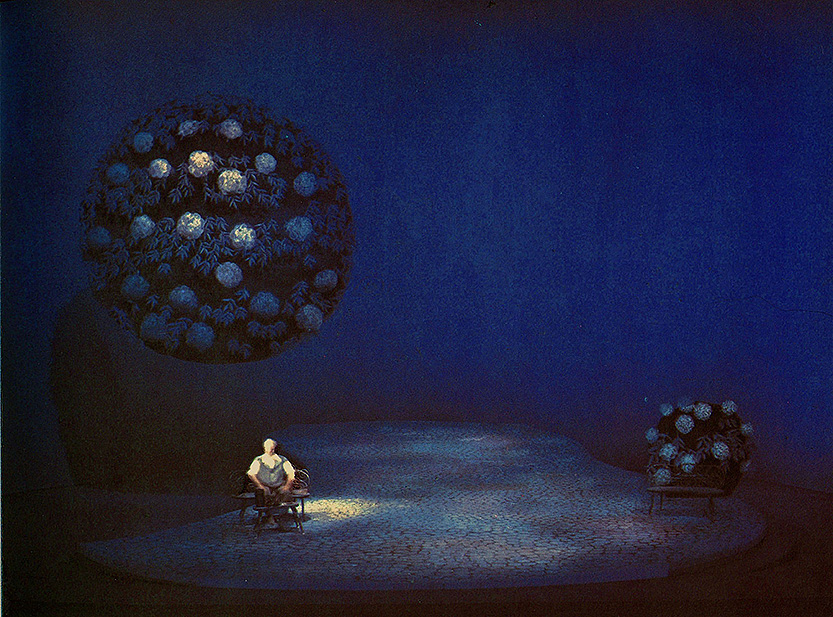
Wieland Wagner's 1956 staging of Die Meistersinger von Nürnberg: ACT II |
| Act III was the unkindest cut of all. Instead of the familiar meadow with the visible ramparts and towering spires of the city in the distance, a section of a steeply-raked stadium, filled with a uniformly dressed chorus, was revealed. The main action, which was highly stylized, took place on a circular performance area. There was no procession of guilds, or colored streamers. The audience was shocked. Immediately the word spread that Wieland Wagner had staged a "Meistersinger ohne Nürnberg:" a Meistersinger without Nuremberg. Of course, Nuremberg, as Wagner knew it, was no more. It was too much for the German post-War public to take. For the first time in its history, there was booing at the Festspielhaus. |
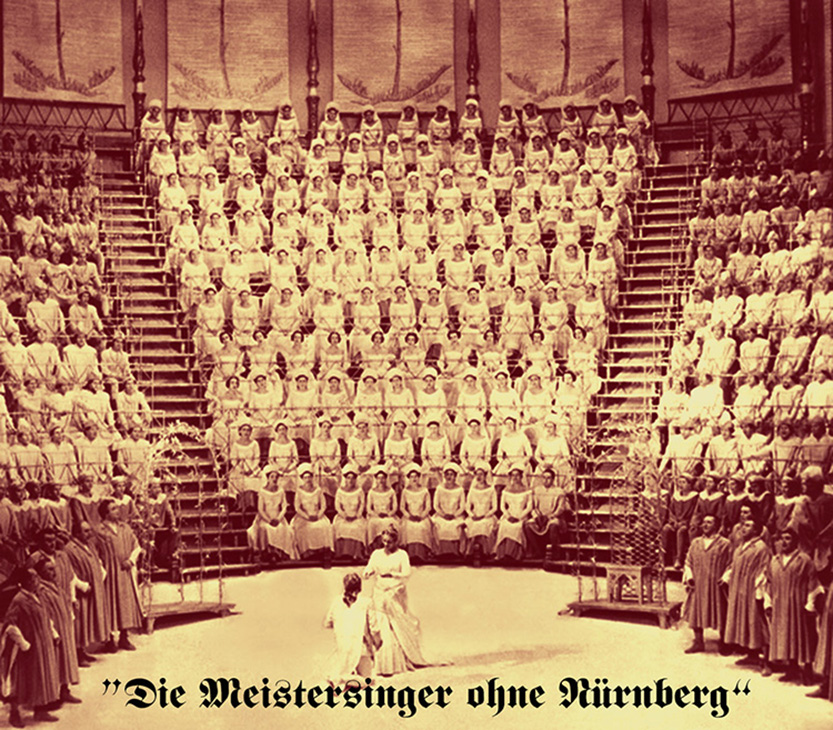
Wieland Wagner's 1956 staging of Die Meistersinger von Nürnberg: ACT III |
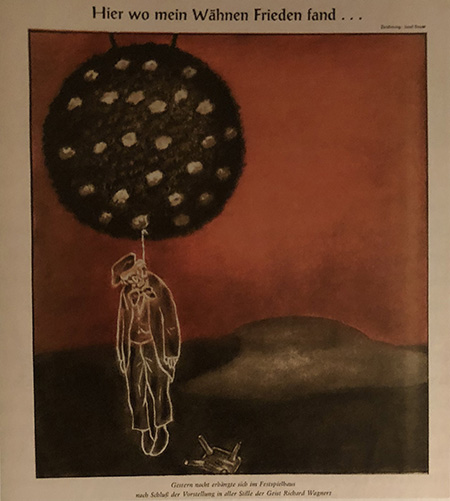 |
In the days that followed the German press lambasted the new production. The Bavarian Justice Ministry deemed Wieland's work a scandal and argued that the Festival should no longer receive public financial support. The right-wing German Party even went on to suggest that the Nazi label "Entartete Kunst" (Decadent Art) be resurrected to discredit the new production. Taking into account what Wieland Wagner was trying to achieve, this production was an artistic triumph. By destroying the expectations of the right-wing Wagnerites, the pre-War staging orthodoxy embraced by the Nazis was abolished. As a result, this production ranks as Wieland's most overtly political rumination on Richard Wagner's work. The production played for six seasons, and as was Wieland's wont, he constantly altered and developed his ideas over the years. Towards the end of the run, interestingly enough, the third act acquired a backdrop with the skyline of Nuremberg. It was unfortunate that so much ink was spilled over the visual merits of this Meistersinger while very little was written about the musical aspect of the production. From the musical point of view it was one of the strongest casts that had been assembled since the reopening of the Festival. All of the principal singers were outstanding, and Hans Hotter's performance as Hans Sachs was, in the words of Penelope Turing "wise and understanding, tender and robustly humorous of his own weaknesses and those of others, as near the ideal Sachs as we are ever likely to see and hear." |
| Above: A caricature showing the spirit of Richard Wagner committing suicide by hanging himself from the famous Wieland Wagner floral ball. Just another example showing how detested this production was by the conservative factions at Bayreuth, and the extent that many went to mock its innovations. |
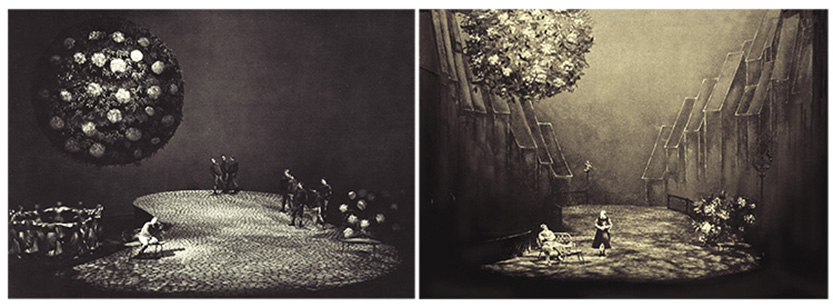
| Ultimately, Wieland caved in. The stark 1956 Act II set (left) went through a transformation. One year later the 1957 Meistersinger Act II set (right) had acquired somewhat of a semblance of a street. The giant footprint, kidney-shaped stage was still there, but the floral ball was raised so it no longer dominated the setting. In addition, abstract Nuremberg buildings were added on either side of the stage. |
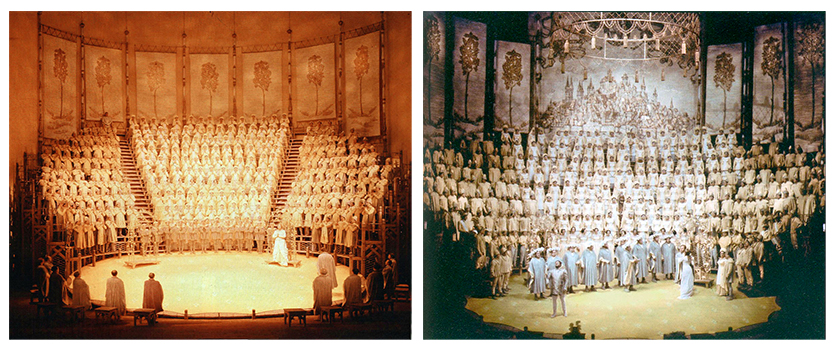
| Also, the much debated third act, which had garnered the title of "The Meistersinger without Nuremberg" went through some changes. Version 2.0., one year later, eliminated the two aisle of steps, although it kept the stadium-like seating where the chorus sat. A chandelier was added to the set, and this gave the decor a much-needed sense of warmth. The pageantry of the pre-War productions remained missing. Arguably the most important change was the addition of Hartmann Schedel's famous lithograph of the city of Nuremberg. |
The above is a segment from Wieland Wagner's Bayreuth Production from 1963. This staging was as disliked as the pivotal, groundbreaking 1956 production, and it only lasted two years. This rare video shows the aria "Morgenlich leuchtend in rosigem Schein" (Walthers Traumlied) from Act III. Hans Sachs - Josef Greindl |
|
